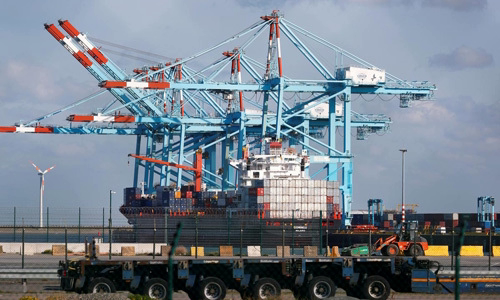After France dismantled the Calais refugee camp in 2016, migrants wishing to come to the UK were forced to take a more dangerous route from the Belgian coast.
The 39-container refrigerated container goes from the port of Zeebrugge, Belgium on a ferry from Cobelfret Ferries, based in Brugge, and docked at the Port of Purfleet in Essex County, east of London, England, at 0:30 am 23/10. .

Zeebrugge port in northwestern Belgium on October 24 Photo: Reuters
The Belgian Federal Prosecutor's Office said "so far" there is no evidence that the victims began their fateful journey from Belgium. "The investigation is to determine how long they died. When the container was shipped across the sea, they might have died inside," said Francois Gemenne, migration researcher at Liege University, Belgium and the Research Institute. study Politics of Paris, said.
However, it is estimated that between 800 and 1,000 migrants are present in Belgium, the country is only 100 km from the British coast, waiting for the opportunity to "promised land" by crossing the sea through the Zeebrugge port or other French port. The closure of the Calais refugee camp, a shabby tent in the north of the country, forced 6,000 migrants to seek new shelter, adding to the burden on Belgium.
"Migrants move in the triangles of Paris, Brussels and Calais," said Mehdi Kassou, who leads a network of care for illegal immigrants from the Middle East, Sudan or Eritrea. Gemenne added that the police are also trying to identify migration routes.
Of the 39 bodies found in container trucks in Essex, 32 km from London, there were 31 men and 8 women. British police initially believed that all the victims were Chinese, but officials were investigating suspected victims of non-Chinese nationality. This incident is thought to be a human trafficking.
This is not the first "death trip" to move through the port of Zeebrugge. In 2000, a container truck carrying 60 Chinese migrants "disguised" with tomato barrels also passed through the port to reach Dover port in Kent county, southeast England. However, the driver closed the vents just before the car arrived at the port of Zeebrugge, killing 58 people in the container.
"The route has changed. In the past, migrants used to travel from Calais to England, but now switch to the E40 motorway in Belgium," said Stef Janssens, who works at the Belgian federal migration center. Trafficking gangs control concentrated parking spots along the highway linking the capital Brussels with the port of Zeebrugge.
The Port of Zeebrugge mainly handles freight cars and very few tourists come here. Sniffing dogs and thermal scanners are used to detect ticket evildoers, but these measures are not as effective for refrigerated containers like the one containing 39 bodies.
In 2014, the body of an Afghan migrant was found in a container at the port of Tillbury in England, while 34 accompanying people survived. The vehicle moved through the port of Zeebrugge at the time the scanner was not in operation. Because every day 4,000 cars pass through the port, the staff cannot afford to inspect each container.
Janssens said traffickers still controlled the points on the E40 motorway, but at the same time looked for more lax security places, so they had gone further north in the past two years. "The route also redirects to Antwerp and ports like Hook of Holland in the Netherlands, because these places are more deserted and less controlled," he explained.
Container truck route carrying 39 people to the UK (click on the image for details). Graphics: Tien Thanh.
The International Organization for Migration (IOM), based in Geneva, Switzerland, said more and more migrants were trying to come to the UK with small boats and there were five sinking boats this year. 39 bodies were discovered in Essex causing the total number of migrants killed on their journey across Europe this year increased to 97, more than 5 people compared to the same period last year.
Experts say accusing traffickers is easy, but systematic solutions are often overlooked. The process of reforming refugee issues across the EU is stalling. The Dublin law, which stipulates that asylum seekers must be registered in the first European country they come to, is putting a heavy burden on Greece and Italy and is ineffective.
"We are stuck in a situation that will inevitably lead to the deaths of refugees, or push them into the hands of traffickers," Kassou said.
"As long as the UK remains an attractive destination, there will be migrants willing to cross the border. This has been going on for a long time and probably will continue even if the UK leaves the EU," Gemenne said. , adding that "traffickers have no interest in the fate of migrants".
"The inhumane trait of human trafficking is that if the 'commodity' disappears, no one will speak out," he said.



 ElisabetaIoanaCovrig
ElisabetaIoanaCovrig







